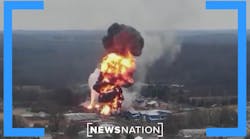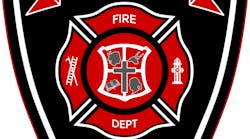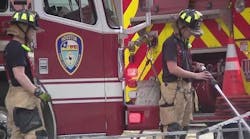KANSAS CITY, Kan. --
Firefighters said Tuesday night they believe they have contained a massive fire at a fuel storage tank in downtown Kansas City, Kan.
Fire Department officials said they plan to let the fire burn itself out. Investigators said a lightning strike started a fire in a large fuel tank at the Magellan Pipeline terminal, located at 401 E. Donovan Road, which is near the GM-Fairfax plant. The terminal handles jet fuel, ethanol, diesel and other fuel oils. Magellan's Jon Jacobs said there were about 1.2 million gallons of unleaded gasoline in the storage tank. Jacobs said the product has been contained to the shell of the tank and the dike area. Adjacent tanks to the fire will be evaluated. The tank exploded shortly before 7:30 p.m., and crews scrambled to prevent other fuel tanks from catching fire. No injuries were reported.
Several witnesses called KMBC saying they heard a loud boom and that black smoke was filling the air.
At about 8:30 p.m., the fire breached the tank and spread to a dirt levee surrounding the tank that was built to contain fuel in the event of a leak.
At about 9:30 p.m., a section of the tank collapsed in the fire.
About 20 minutes later, another section of the tank collapsed, falling in on itself. Firefighters said that's a good sign that the fire is being contained within the structure of the tank.
An off-duty firefighter at the scene estimated it could take two days for the fire to burn out.
The heavy smoke caused visibility problems at the downtown Kansas City airport. Late Tuesday night, the Federal Aviation Administration closed the airport for the overnight hours. Airport spokesman Joe McBride said it reopened at 6:15 a.m.
During a news conference Tuesday morning, Katy Miley of the U.S. Environmental Protection Agency said air-quality monitoring continues at 60 locations around the metro to assess environmental impacts from the massive fire.
The EPA is checking for volatile organic compounds. Miley said there are no levels of concern in the Kansas City area. The highest reading they received as EPA crews checked for what they call particulate, which is soot or dust, was at 80 micrograms per cubic meter in the area of Highway 169 at midnight. Miley said that level has continued to go down. EPA results will be posted on its Web site.
Copyright 2008 by KMBC.com. All rights reserved. This material may not be published, broadcast, rewritten or redistributed.





